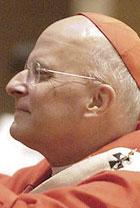 |
 |
|||||
 |
 |
 |
 |
 |
|||
 |
Church is changed but vital, involved
By Tom Sheridan Editor Cardinal George painted a picture of a vital—if reduced—Catholic Church in Chicago, a church engaging society at many levels and striving to tell people that God loves them at an April 6 talk to the City Club of Chicago. The cardinal acknowledged that the church has changed in the last half-century, but said it continues to confront important issues, within and without its own community. City Club president Tom Donovan introduced the cardinal by outlining some of the shifts he’s seen since he was confirmed by Cardinal Samuel Stritch in 1955. He pointed to fewer priests, fewer people in the pews, fewer schools and questions of public trust in the church. True, conceded Cardinal George, there are fewer priests and fewer Catholic schools now, and it continues to be a struggle to make up a $120 million annual shortfall between school revenues and operating costs. The cardinal praised school voucher programs in other parts of the country that help accomplish that, pointing to the successful one currently operating in Washington D.C. But he said the church’s mission continues to be the same, to evangelize and to preach the Gospel of Jesus Christ. This is not a “program,” he stressed, “but a purpose that permeates everything we do.” Even if the church’s services and institutions were to disappear, the cardinal said, this task would remain. Structures have changed for the better, regarding staffing and governance since Vatican II, he said. More than 600 deacons have bolstered the ordained clergy. There is increased lay involvement with trained pastoral associates and other lay ecclesial ministers. Church governance has also improved substantially since Vatican II, the cardinal said. The church is vastly different ethnically as well, he said, with many immigrants and especially a large and growing Hispanic presence. “Mass is celebrated each Sunday in 27 languages,” he said. English is not the primary language in the homes of about half of Chicago-area Catholics, he said. So the church strives to understand the culture from which these Catholics spring, including forming priests from many cultures and recruiting them from many nations. But there are challenges. The clerical sexual abuse crisis is one, the cardinal said. Despite the case involving Father Daniel McCormack in which policies broke down, he said the church has done much “to make sure that children are genuinely safe,” including training of clergy, ministers, employees, volunteers and children. Two independent reports pointed out areas the church must correct, but the cardinal repeated that there are no priests or deacons in ministry who have been credibly accused, and that the church works closely with civil authorities when accusations are made. Such incidents, however, “make it very difficult to tell people they are loved … or that they can trust (the church). And, he said, “that’s what the church is supposed to be about, to tell people God loves them.” Changes over the last 50 years are not necessarily weaknesses, he said. Catechesis has been much improved, he said. And there are more Catholic universities, more health care centers and hospitals and social service efforts. This is true despite the growth of secularism which weakens society, he said. The church, said the cardinal, is a public enterprise whose continual goal is to call people to change around such issues as immigration, racism, housing, violence, sexual morality. “These,” he said, “are more complicated issues” than they were a half-century ago. While the church has been present in Chicago since the late 17th century, the Archdiocese of Chicago was formed in 1843. Since then, the cardinal said, “the church has been a continual presence in education, health care and charitable and social services.” But even without all that, he said, the mission of the church is to continue to preach God’s word and tell them God loves them. |
||
|
|
|||